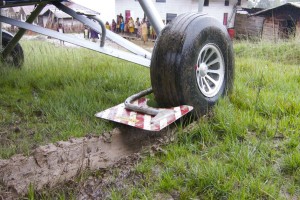 |
| PC-6 right wheel bogged in |
Before I answer that question, I’m going to try and explain the theory on why tailwheel aircraft pull left on take-off. P-factor is just one of the things causing this, however there are a couple of other forces at play which contribute, gyroscopic precession and engine torque. For the purposes of this article, we will assume a clockwise spinning propeller when viewed from the pilot’s seat.
P-Factor
The simplest way to understand this is to remember each propeller blade is an aerofoil and when spinning they’re moving through the air producing lift, just like the wings of an aircraft (abet that lift is actually thrust here acting along the length of the aircraft).
When on the ground, tailwheel aircraft have a naturally nose high attitude. The spinning propeller (prop disk) is mounted on the front of this up-pointing nose and thus is presented to the air at an angle. Because of this, the descending propeller blade (the one on the right when viewed from the cockpit) is moving through the air at a higher angle of attack than the ascending blade. That higher angle of attack means the descending blade produces more lift (forward thrust) than the ascending blade. That extra thrust on the right side of the aircraft causes it to yaw to the left. And the faster the propeller spins, the more extra thrust is produced on the right side and the more the aircraft pulls to the left.
Once the nose is level (i.e. when you’re flying), p-factor is zero as all blades are moving through the air at the same angle of attack relative to the airframe. This is why nose-wheel aircraft are not affected by p-factor as their propellers are usually not nose high when on the ground.
 |
| Typical nose high attitude on the ground |
Engine torque
Simply put, the torque of the engine spinning the propeller clockwise acts along the lateral axis (nose to tail) to cause the whole airframe to twist in an anti-clockwise direction when viewed from the cockpit. In addition to this, the left wheel is pushed into the ground more than the right wheel causing more drag on that wheel which also causes the aircraft to pull to the left. The only way to compensate for this is opposite (i.e. right) aileron. However, until you’ve got the speed up, that will have no effect on things.
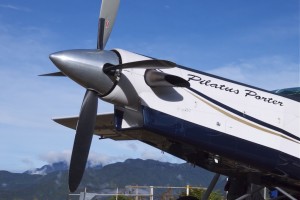 |
| PC-6’s long nose housing a 550SHP P&W PT6 |
Gyroscopic precession
We all remember our gyro theory right? Probably not, so rather than going into all that dry theory I’ll try to explain it purely with relation to tailwheel aircraft. To understand how this affects the departure, imagine you’re sitting in the cockpit looking at the propeller disk spinning clockwise in-front of you. Now, gyroscopic precession dictates that a force applied to a spinning disk will act at 90 degrees in the direction of the rotation.
As the tail of the aircraft is raised before rotation, you are effectively applying a pushing force to the top of the propeller disk. This force moves through 90 degrees in a clockwise direction which is to the right side of the propeller disk. It’s this force that then yaws the aircraft to the left.
With the Porter, this is less of a problem as we tend to depart in a nose high attitude but still worth considering on departure. P-factor is by far the biggest force causing the leftwards tendency on departure.
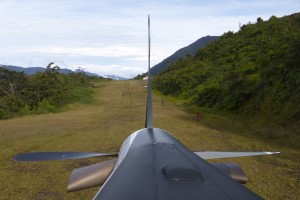 |
| Lined up for departure at Idedua, Papua |
So, going back to the original question, what happens when departing from a short, very muddy, slopping airstrip with zero grip in a large, powerful taildragger?, in the case of Kegata it gets pretty hairy, very quickly is the answer!
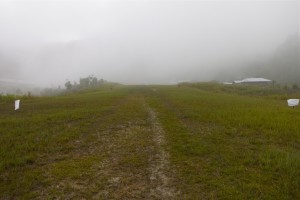 |
| View looking up Kegata as the occasional cloud rolls across |
The weather here in Papua these past couple of weeks has been very wet with a lot of rain falling every day. As a result we’ve been forced to close a few airstrips as they’re just too dangerous to operate from when the ground is so wet. Kegata has just become the next one on the list until things dry out.
The landing at Kegata was uneventful although the turnaround resulted in getting stuck side on to the airstrip requiring half an hour of digging to un-stick the left tyre. As Kegata has a decent slope to it, that meant a lot of fuel slowly transferred from the right wing tank and into the left tank. The Porter has no way of preventing this as both wing tanks are interconnected via a collector tank.
 |
| Digging the left wheel out |
The usual way of departing from a slippery airstrip in the Porter is to start with the nose pointing to the right, to help counteract the p-factor and engine torque. However, on this departure I didn’t have it pointing quite enough to the right, as I was soon to discover. As I started rolling and increased the power, the aircraft began to slide left not helped by the extra fuel in the left tank.
Now, there’s a split second window once you start rolling in which you have two choices, continue the take-off or abort. The later would have resulted in the aircraft going off the left side of the airstrip. Once rolling down the slope with zero braking action there is no way of stopping. So, with full right rudder, toe brake and right aileron we slide down the airstrip fully sideways as I increased the power enough to get us airborne but not so much as to pull the aircraft off the left side of the airstrip.
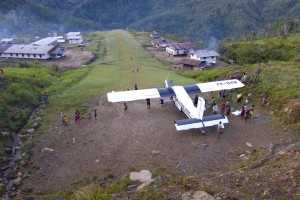 |
| Parked up at Kegata, Papua |
It was a major lesson in the effects of p-factor and engine torque. Chatting with one of Papua’s most experienced Porter pilots, he mentioned he usually starts with the nose pointing 20 degrees off to the right on really slippery slopes. That result’s in a fairly straight take-off roll, abet fully sideways, which in his words is “scary as hell!”. I’ll remember that next time!
Discover more from Matt Dearden
Subscribe to get the latest posts sent to your email.

Thank you for posting, great blog and very interesting.
You’re welcome. It was good to write this one as it forced me to read up on it all and refresh my memory. That take-off is one I won’t forget in a hurry, that’s for sure!
Matt,
Do you ever wheel land the PC6?
Not on the short airstrips but on the longer ones sometimes I will, especially with a forward C of G (e.g. when empty). I also find it’s easier to control the roll-out on badly constructed tarmac airstrips with lots of undulations. With a three pointer those undulations can throw you off line, requiring some quick rudder/brake work. With a wheeler landing they don’t and it’s more controllable. This is all in my opinion however and it’s an often discussed topic among PC-6 pilots.
great article Matt! I’ve just discovered your blog, love it!
Cheers Butch! Glad you’re enjoying it :o)
umm. p-factor as you describe it only happens as you’re moving forwards though (unless i’m misunderstanding): the faster you move forwards while “nose-high”, the more pronounced the effect is; the extremes are: standing still (no p-factor, though, especially on a taildragger, there’s still “something”, see below), respectively: chopper (rotary wing) moving forwards at almost 0 deg angle to the plane of rotation of the “propeller” (choppers need to have an asymmetric (cyclic) pitch because of this, otherwise the blade going into the wind will have much more lift than the one running away from the wind, which would obviously roll the chopper)
still something: there’s still corriolis-type (?) effects: the, airflow from the propeller is not “clean”, it is “twisted” by the prop, which is significant so close behind the prop, the effect is that the actual flow on the rudder, as pushed by the prop, will actually be considerably sideways, and also one of the wings will actually get slightly more lift than the other (this is most obvious to glider pilots when towed by powerful tow planes, especially on the takeoff roll); so if you have no grip, all these combined with torque and gyro-effect will probably be enough to turn you slightly as you push the gas forward on such a big engine. I wouldn’t underestimate the gyro effect though, i suppose you spin that prop somewhere around 3000rpm on takeoff, that means very nearly a big bad gyro in front, it doesn’t take much of tail lifting to make it precess, i would think
oh, did i mention what a great blog this is? please keep writing, and thank you. that, and gopro should consider “lending” you some gear ;). great stuff
Hi there and thanks for your comments.
You’re quite right about p-factor increasing as you speed up along the take-off roll; I probably should have mentioned that in the article, so thanks for clearing that up for anyone reading this.
The swirling prop-wash does indeed also have an effect on things, although with the Porter not as much as the torque and p-factor in my experience. Prop RPM is 2000 at all times with the Porter when flying.
The gyro effect is noticeable if you deliberately pick the tail up once rolling and you do have to press a little harder on the right rudder to keep things straight but as I mentioned, we tend to depart from the shorter airstrips in the same nose-high attitude as when sitting on the ground, so it’s less of an issue.
All you really have to know though is, that you need rather a lot of right rudder trim (i.e. full) and pedal to keep things straight but it’s always good to understand the theory as to why.
Cheers! And if GoPro want to “lend” me anything I’m all ears ;o)
right, i keep forgetting it’s a turboprop. weird (wonderful) things (re rpm).
thanks again, theory is all good and fun, but it’s different to have the “hands on view”, so thanks for that
cheers, see you around
Great live example for tailwheel training briefings
No worries!
If the P-factor gives more lift to the right side of the prop disk, then why doesn’t the gyroscopic procession mean you get a nose-up moment from it? Shouldn’t the force on the right side move 90 degrees to act on the bottom of the disk?
Hi,
Good question and I see what you’re getting at but I’m fairly sure that because P-factor is not a force acting on the prop disc but rather is thrust produced by the prop disc, it does not produce any gyroscopic procession.
Even if it did, because this would be basically forcing the tailwheel onto the ground, you would be hard pressed to notice it compared to the other forces in play.
Perhaps someone with more understanding of gyros could add something further to this discussion?
Cheers
May be that is why Pilatus decided to set a 2° angle off the centerline of the transversal axe; so it would help to minimize this force…
Oh, and – on my Zenair CH701 STOL, I have to apply opposite rudder compared to take-off, when I go to a steep descent with throttle far back.
Very nice article; everyone (I mean *everyone*) should fly taildraggers at some time in his/her pilot’s career, maybe even continue to do so.
I forgot: can you apply reverse prop pitch after touchdown on a Porter?
You certainly can! Rarely used though unless you’ve made a bit of a hash of the landing and find yourself hurtling towards the end of the runway with both wheels locked..